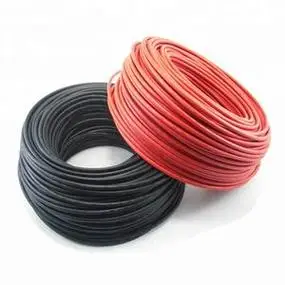1. Compatibility with Solar Energy Systems
In a solar power generation system, the electricity generated by photovoltaic modules needs to be collected and transmitted through cables to devices such as inverters. The rated voltage of a 16-square-millimeter low-voltage cable is 0.6/1kV, which fully meets the voltage requirements for low-voltage direct current or alternating current power transmission in solar systems. The conductor of this cable is made of high-purity copper or aluminum, which has a low resistance and can effectively reduce energy loss during transmission, thereby improving the overall efficiency of the solar power generation system.
At the same time, the operating environment of a solar system is relatively complex and may be affected by natural factors such as high temperatures, ultraviolet radiation, rain, and wind. If a 16-square-millimeter low-voltage cable uses an XLPE insulation layer and a PE sheath layer, the XLPE insulation layer has excellent heat resistance and aging resistance, and can work stably at high temperatures for a long time; the PE sheath layer has good weather resistance, anti-ultraviolet properties, and waterproof performance, which can resist the erosion of outdoor harsh environments on the cable and ensure the long-term reliable operation of the cable in the solar system.
2.Specific Applications in Solar Energy Systems
Connection between photovoltaic modules: In a solar panel array, the electrical energy generated by each photovoltaic module needs to be connected through cables to form a DC current collector circuit. A 16-square-millimeter low-voltage cable can carry the large current generated by the string of photovoltaic modules, effectively collecting the electrical energy of multiple photovoltaic modules and laying the foundation for subsequent power transmission. Its good flexibility makes the wiring between photovoltaic modules more convenient and enables it to adapt to different installation layouts.
Connection between the combiner box and the inverter: The combiner box collects the electrical energy from multiple strings of photovoltaic modules and then needs to be transmitted to the inverter through cables for the conversion from direct current to alternating current. The current-carrying capacity of the 16-square-millimeter low-voltage cable can meet the transmission requirements for the larger current after the combiner, ensuring that the electrical energy is efficiently and stably transmitted from the combiner box to the inverter, thereby reducing the energy loss at this stage.
Connection of the inverter to the power distribution system: After converting DC electricity to AC electricity, the inverter needs to be connected to the power distribution system via cables to achieve the distribution and utilization of electrical energy. A 16-square-millimeter low-voltage cable can stably transmit the AC electricity output by the inverter to the power distribution system, meeting the connection requirements of the solar power generation system with the grid or loads, and ensuring the safe supply of electrical energy.
3.Installation and Maintenance Tips
Installation precautions: When installing 16 square millimeter low-voltage cables in a solar system, follow the relevant installation specifications. The laying temperature should be no lower than 0℃. Avoid damage caused by low temperature as it may reduce the flexibility of the cables. At the same time, pay attention to the bending radius of the cables. The minimum bending radius for single-core non-armored cables is no more than 20D, and for multi-core non-armored cables, it is no more than 15D to ensure that the internal structure of the cables is not damaged. When laying outdoors, try to avoid exposing the cables directly to intense sunlight. You can use conduit or overhead methods for protection to further extend the service life of the cables.
Maintenance Points: Regularly inspect the cables to check if the insulation layer and sheath layer are damaged or aging. If any problems are found, they should be replaced immediately. At the same time, check if the connection parts of the cables are secure and if there are any loosening or overheating conditions to ensure the safety and stability of power transmission. After severe weather, conduct a comprehensive inspection of the cables and promptly address any potential faults that may arise.
4.Product parameters












